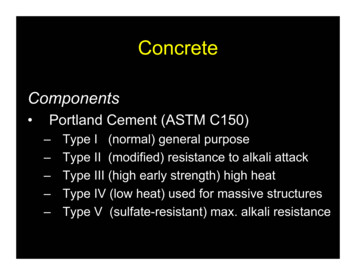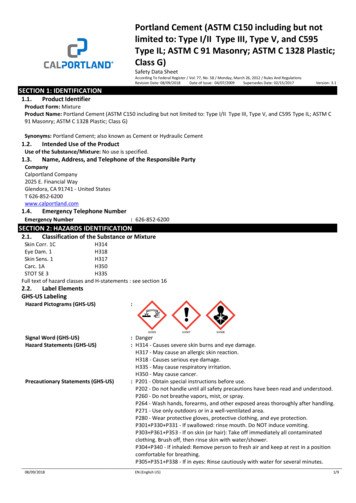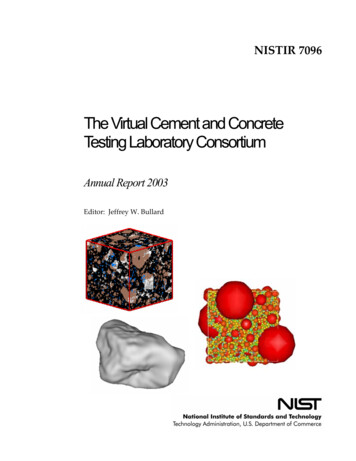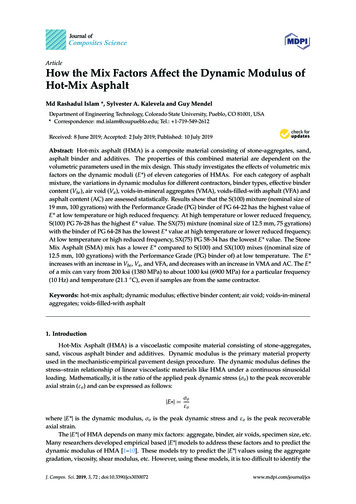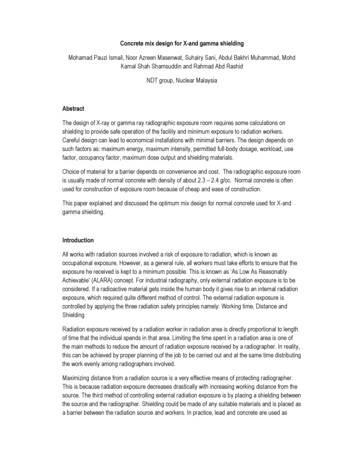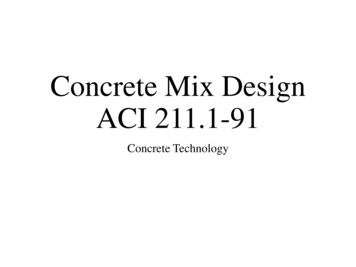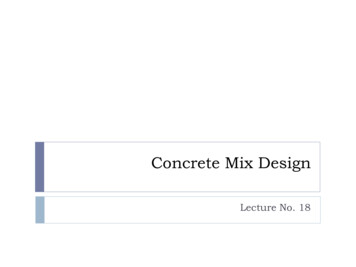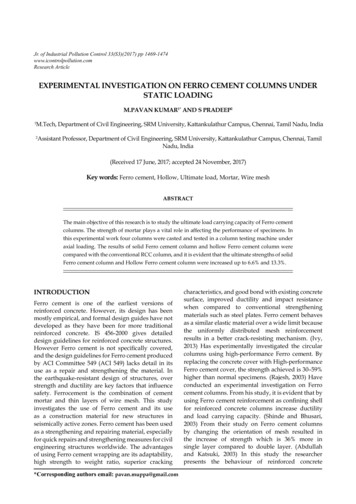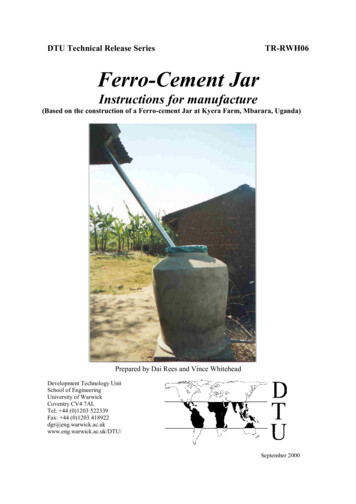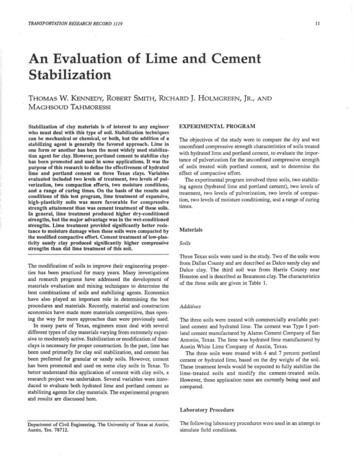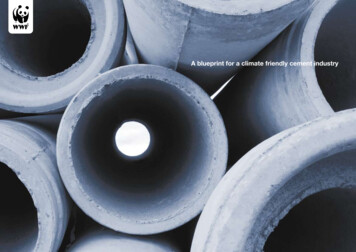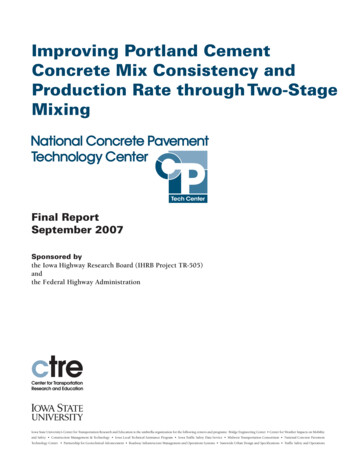
Transcription
Improving Portland CementConcrete Mix Consistency andProduction Rate through Two-StageMixingFinal ReportSeptember 2007Sponsored bythe Iowa Highway Research Board (IHRB Project TR-505)andthe Federal Highway AdministrationIowa State University’s Center for Transportation Research and Education is the umbrella organization for the following centers and programs: Bridge Engineering Center Center for Weather Impacts on Mobilityand Safety Construction Management & Technology Iowa Local Technical Assistance Program Iowa Traffic Safety Data Service Midwest Transportation Consortium National Concrete PavementTechnology Center Partnership for Geotechnical Advancement Roadway Infrastructure Management and Operations Systems Statewide Urban Design and Specifications Traffic Safety and Operations
About the National Concrete Pavement Technology CenterThe mission of the National Concrete Pavement Technology Center is to unite key transportationstakeholders around the central goal of advancing concrete pavement technology throughresearch, tech transfer, and technology implementation.Disclaimer NoticeThe contents of this report reflect the views of the authors, who are responsible for the factsand the accuracy of the information presented herein. The opinions, findings and conclusionsexpressed in this publication are those of the authors and not necessarily those of the sponsors.The sponsors assume no liability for the contents or use of the information contained in thisdocument. This report does not constitute a standard, specification, or regulation.The sponsors do not endorse products or manufacturers. Trademarks or manufacturers’ namesappear in this report only because they are considered essential to the objective of the document.Nondiscrimination StatementIowa State University does not discriminate on the basis of race, color, age, religion, nationalorigin, sexual orientation, gender identity, sex, marital status, disability, or status as a U.S.veteran. Inquiries can be directed to the Director of Equal Opportunity and Diversity,(515) 294-7612.
Technical Report Documentation Page1. Report No.IHRB Project TR-5052. Government Accession No.3. Recipient’s Catalog No.4. Title and SubtitleImproving Portland Cement Concrete Mix Consistency and Production Ratethrough Two-Stage Mixing5. Report DateSeptember 20077. Author(s)Tyson D. Rupnow, Vernon R. Schaefer, Kejin Wang, Benjamin L Hermanson8. Performing Organization Report No.9. Performing Organization Name and AddressCenter for Transportation Research and EducationIowa State University2711 South Loop Drive, Suite 4700Ames, IA 50010-863412. Sponsoring Organization Name and AddressIowa Highway Research BoardFederal Highway AdministrationIowa Department of TransportationU.S. Department of Transportation800 Lincoln Way400 7th Street SWAmes, IA 50010Washington, D.C. 2059010. Work Unit No. (TRAIS)6. Performing Organization Code11. Contract or Grant No.13. Type of Report and Period CoveredFinal Report14. Sponsoring Agency Code15. Supplementary Notes16. AbstractA two-stage mixing process for concrete involves mixing a slurry of cementitious materials and water, then adding the slurry to coarseand fine aggregate to form concrete. Some research has indicated that this process might facilitate dispersion of cementitious materialsand improve cement hydration, the characteristics of the interfacial transition zone (ITZ) between aggregate and paste, and concretehomogeneity.The goal of the study was to find optimal mixing procedures for production of a homogeneous and workable mixture and qualityconcrete using a two-stage mixing operation. The specific objectives of the study are as follows: (1) To achieve optimal mixing energyand time for a homogeneous cementitious material, (2) To characterize the homogeneity and flow property of the pastes, (3) Toinvestigate effective methods for coating aggregate particles with cement slurry, (4) To study the effect of the two-stage mixingprocedure on concrete properties, (5) To obtain the improved production rates. Parameters measured for Phase I included: heat ofhydration, maturity, and rheology tests were performed on the fresh paste samples, and compressive strength, degree of hydration, andscanning electron microscope (SEM) imaging tests were conducted on the cured specimens. For Phases II and III tests included slumpand air content on fresh concrete and compressive and tensile strengths, rapid air void analysis, and rapid chloride permeability onhardened concrete.17. Key Wordshomogeneity—interfacial transition zone—mixing energy—mixing methods—rheological properties—two-stage mixing18. Distribution StatementNo restrictions.19. Security Classification (of thisreport)Unclassified.21. No. of Pages22. Price96NAForm DOT F 1700.7 (8-72)20. Security Classification (of thispage)Unclassified.Reproduction of completed page authorized
IMPROVING PORTLAND CEMENT CONCRETE MIXCONSISTENCY AND PRODUCTION RATE THROUGHTWO-STAGE MIXINGFinal ReportSeptember 2007Principal InvestigatorVernon R. SchaeferProfessor of Civil, Construction, and Environmental EngineeringIowa State UniversityCo-Principal InvestigatorKejin WangAssociate Professor of Civil, Construction, and Environmental EngineeringIowa State UniversityResearch AssistantsBenjamin L. HermansonTyson D. RupnowAuthorsTyson D. Rupnow, Vernon R. Schaefer, Kejin Wang, and Benjamin L. HermansonSponsored bythe Iowa Highway Research Board(IHRB Project TR-505)andthe Federal Highway AdministrationPreparation of this report was financed in partthrough funds provided by the Iowa Department of Transportationthrough its research management agreement with theCenter for Transportation Research and Education.Center for Transportation Research and EducationIowa State University2711 South Loop Drive, Suite 4700Ames, IA 50010-8634Phone: 515-294-8103Fax: 515-294-0467www.ctre.iastate.edu
TABLE OF CONTENTSACKNOWLEDGMENTS . XIEXECUTIVE SUMMARY .XIIIINTRODUCTION .1Background .1Objectives .1Phase I.2Phase II .2Phase III .2PHASE I: LABORATORY INVESTIGATION OF MIXING EFFECTS ON PASTEPROPERTIES .3Literature Review .3Experimental Work.10Paste Test Results .16Summary of Phase I Findings .30PHASE II—TWO-STAGE LABORATORY STUDY ON CONCRETE.32Literature Review .32Experimental Work.38Laboratory Two-Stage Mixed Results.40Summary of Phase II Findings.46PHASE III—TWO-STAGE FIELD STUDIES.48Objectives/Scopes .48Field Equipment for Two-Stage Mixing.48Project One—Highland, Illinois .55Project Two—Jordan, Minnesota .64Project Three—Iowa.73CONCLUSIONS AND RECOMMENDATIONS .76Major Research Findings .76Recommendations.77REFERENCES .79v
LIST OF FIGURESFigure 1. Typical rheology flow curve (Wang, Konsta-Gdoutos, and Shah 2001) .5Figure 2. Plastic viscosity as a function of pre-shear rate (Williams, Saak, and Jennings 1999) .6Figure 3. Hysteresis loop area as a function of pre-shear rate (Williams, Saak, and Jennings1999) .7Figure 4. Effect of mixing methods on peak stress of cement paste (Yang and Jennings 1995) .8Figure 5. Delayed increase in rheometric properties due to continued stirring (Vlachou and Piau1997) .9Figure 6. Yield stress relationship between conventional rheological models and the vanemethod (Dzuy and Boger 1985).10Figure 7. Hobart mixer.13Figure 8. Chandler Engineering Waring Blender .13Figure 9. Rheology results for speed two, 100% PC, Hobart mixer.17Figure 10. Rheology results for speed one, 100% PC, high shear mixer .17Figure 11. Rheology results for speed two, 100% PC, high shear mixer .18Figure 12. a) (Top) Yield stress results for the 40 x 80 mm vane .19Figure 13. a) (Top) Yield stress results for the 15 x 30 mm vane .20Figure 14. a) (Top) Thixotropic areas for the 40 x 80 mm vane .21Figure 15. a) (Top) Peak stress results for the 40 x 80 mm vane .22Figure 16. Heat of hydration results for 100% PC, Hobart mixer .23Figure 17. Heat of hydration results for 100% PC, high shear mixer.24Figure 18. Comparison of degree of hydration for the high shear mixer and Hobart mixer .25Figure 19. Degree of hydration results for the high shear mixer.25Figure 20. Three-day compressive strength for 100% PC.28Figure 21. SEM image for the high shear mixer, 100% PC, speed two, 60 seconds.29Figure 22. Computer-adjusted SEM image for the high shear mixer, 100% PC, speed two, 60seconds.29Figure 23. Cross-section of a drum mixer (Ferraris 2001) .32Figure 24. Various blade configurations for a pan mixer (Ferraris 2001).33Figure 25. Micro-hardness of ITZ after curing 28 days (Tamimi 1994) .35Figure 26. Average 28-day compressive strength values (Pope and Jennings 1992).38Figure 27. Effects of mixing method on the air content of fresh concrete .41Figure 28. Effects of mixing method on the slump of fresh concrete.41Figure 29. Effect of time on compressive strength for mix one (100% PC) .42Figure 30. Effect of time on compressive strength for mix two (85% PC–15% FA).43Figure 31. Effect of time on compressive strength for mix three (50% PC–35% slag–15% FA) .43Figure 32. Effects of mixing method on 56-day split tensile strengths (average of three samples)45Figure 33. Hydromix apparatus (Hydromix Inc. 2007) .49Figure 34. Batching process for the Hydromix two-stage mixing operation (Hydromix Inc. 2007)49Figure 35. Two-stage mixing plant (Concrete Mobility 2007).50Figure 36. Two-stage mixing plant on site .51Figure 37. Countercurrent concrete mixer (Advanced Concrete Technologies 2007) .52Figure 38. Two countercurrent concrete mixers working in tandem (Advanced ConcreteTechnologies 2007).52Figure 39. Countercurrent concrete mixer schematic (Advanced Concrete Technologies 2007) .53Figure 40. Powder-liquid high shear mixer (IKA 2007) .54vii
Figure 41. Powder-liquid high shear mixer schematic (IKA 2007) .54Figure 42. Water jet mixer (Vortex Ventures 2007).55Figure 43. Location of field project one—Highland, Illinois .56Figure 44. Flow chart illustrating the Hydromix mixing process.57Figure 45. Underneath side of the Hydromix plant .58Figure 46. Close-up of screw auger case and water injection nozzles .58Figure 47. Aggregate belt charging ready mix concrete truck .59Figure 48. Effect of mixing procedure on unconfined compression strength (average of threesamples) .62Figure 49. Location of field project two near Jordan, Minnesota.65Figure 50. Plant site for project two near Jordan, Minnesota .65Figure 51. Flow chart illustrating the two-stage mixing process for Jordan, MN.66Figure 52. Rotating fingers in the slurry pre-mixer .67Figure 53. Slurry being charged with aggregate.68Figure 54. Belt for charging the fine and coarse aggregate .68Figure 55. Effects of mixing procedure and time on unconfined compression strength (average ofthree samples) .71Figure 56. Two-stage mixing tower.73Figure 57. CP Tech Center mobile concrete laboratory .74viii
LIST OF TABLESTable 1. Hysteresis loop area and plastic viscosity for samples not subjected to pre-shear(Williams, Saak, and Jennings 1999).6Table 2. Chemical composition and fineness of binders .11Table 3. Binder proportions by volume .12Table 4. Binder proportions by weight .12Table 5. Combinations of mixing time and mixing speed .14Table 6. Average compressive strengths for the Hobart mixer for 100% PC mix 1 .26Table 7. Average compressive strength for the high shear mixer for all mix designs.27Table 8. Percentage of unhydrated cement particles for 100% cement.30Table 9. Comparison of concrete properties mixed by two-stage and normal mixing processes(Rejeb 1996) .37Table 10. Concrete mix design proportions.39Table 11. Effects of mixing method on hardened concrete air properties .44Table 12. Effects of mixing method on chloride permeability .46Table 13. Chemical composition of binders used in Highland, Illinois .60Table 14. Concrete mix proportions for Highland, Illinois .60Table 15. Effect of mixing methods on fresh concrete properties.61Table 16. Compressive strength results for Highland, IL with standard deviation .62Table 17. Effect of mixing methods on 56-day split tensile strength .63Table 18. Effect of mixing method on chloride permeability.63Table 19. Chemical composition of binders used in Jordan, Minnesota .69Table 20. Concrete mix proportions for Jordan, Minnesota .69Table 21. Effect of mixing methods on fresh concrete properties.70Table 22. Compressive strength results for Jordan, MN with standard deviation.71Table 23. Effect of mixing methods on 56-day split tensile strength .72Table 24. Effect of mixing method on chloride permeability.72ix
ACKNOWLEDGMENTSThe authors would like to acknowledge the sponsors of this research: the Iowa Department ofTransportation (through the Iowa Highway Research Board) and the Federal HighwayAdministration. The authors would also like to acknowledge Schwend’s Red-E-Mix, Cemstone,and Concrete Mobility for their participation in this study.
About the National Concrete Pavement Technology Center The mission of the National Concrete Pavement Technology Center is to unite key transportation stakeholders around the central goal of advancing concrete pavement technology through research, tech t
